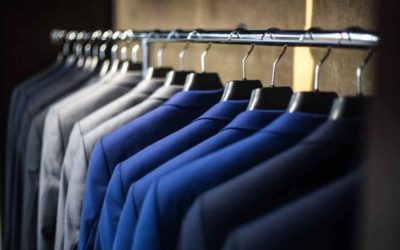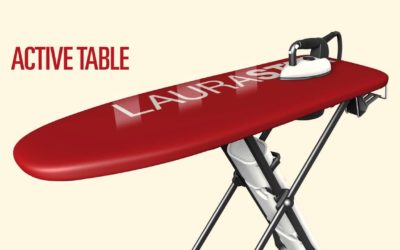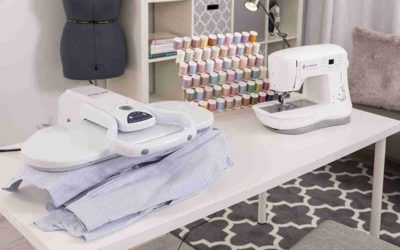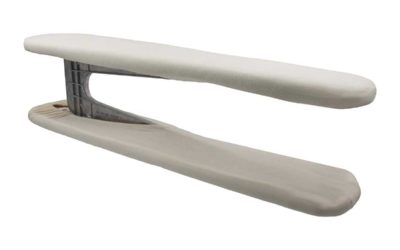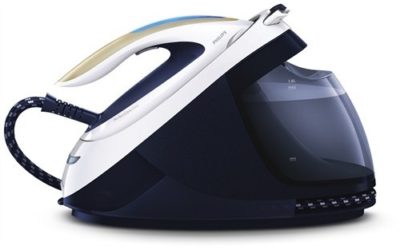An iron removes creases from textiles and ensures smooth, neat laundry. No matter whether shirts, jeans or curtains need to be shaped - iron is the ideal household helper. The iron was used to smooth textiles from as early as the 15th century. However, that time they...
In the Ironing section, we show you various ways of removing wrinkles from your clothes and with the best suitable method for you. We will also show you how to operate an iron correctly and what different types of iron you can choose from.
Iron clothes are an absolute necessity when it comes to making a good impression.
A few years ago, there was saying that someone who does not iron properly has no order in his life.
Nowadays, the market is increasingly offering laundry items that do not require ironing because they use already crumpled fabric. Nevertheless, it always makes sense to know the basics of ironing.
Best Steamer for Clothes | Buyers Guide
Steamer for clothes is the perfect addition to your iron. It is handy, space-saving and works completely without pressure, which is why it acts as a good travel tool. Another advantage is that you can safely use it even for most delicate fabrics. A steam brush should...
Best Ironing Boards | Recommendation and Buyers Guide
How much wrinkle-free clothing is important to you? Then an ironing board is probably part of your household's standard equipment. The choice of the right ironing board is not easy. In this post we will cover everything about ironing boards. There are many different...
Best Steam Press | Recommendation and Buyers Guide
The steam press is much more than conventional iron and offers several advantages. There are not many types of ironing presses, as they all work on the same principle. The price difference is mainly due to additional features like a stand for the press and the brand...
Best sleeve ironing board | Buyers guide
Sleeve ironing boards are much narrower and smaller than conventional ironing boards and fit into the sleeves due to their elongated shape. Sleeve boards are a recent development to the ironing world. They offer many advantages over traditional board, but there are...
Best Rowenta Iron with Buyers Guide
We want to make your purchase decision easier and help you find the best Rowenta iron. We have put together extensive background information for you and added a summary of customer reviews online. You can also find answers to frequently asked questions in our guide....
Best Garment Steamer | Buyers Guide & Recommendation
Do you want to iron certain items of clothing particularly carefully because fabrics such as silk or lace are very sensitive? Then you should get a Garment Steamer in addition to the iron. With this, you can smooth very sensitive fabrics, as well as curtains. How...
Best steam ironing system | Buyers Guide
A steam ironing system is a right choice for you if you have a large household and prefer wrinkle-free laundry. A steam ironing system is a combination of a steam generator, iron, and ironing board. This kind of system takes up a lot of space when storing, so a...
Best steam generator irons | Buyers Guide
Steam generator irons enable you to do your ironing work in a much shorter time and with less effort. Basic types are steam generator irons with pressure boilers and steam generator irons without pressure boilers. Both types are on the market in many different...
What Is Ironing?
Ironing involves smoothing laundry using a warm or hot object. During washing, wrinkles appear in the fabric due to the constant circulation of the fabric. Once the fabric is completely dry, these wrinkles become very apparent. To get the fabric back into shape, you need to iron them.
Iron as a household item works with electricity and has a metal sole. The down part heats up so that you can iron the fabric with ease.
An alternative for the iron is the so-called ironing machine, which is big and usually suitable for commercial use.
Ironing is not a new concept and had a long history. For example, a pan iron was used for this purpose in the Han Dynasty. However, the first real irons appeared from the 15th century.
From the 19th century onwards, coal iron becomes popular as they can retain heat for a longer time and were more efficient.
In modern-day electric irons, the top part is of thermoplastic and the heating part is of stainless steel.
Depending on the manufacturer, there can be additional layers to ensure easier sliding on the laundry.
Difference Between A Steam Iron and Ironing Machine
Nowadays, iron is an easy-to-use device that is common in every household. Most people prefer steam iron are more efficient as it uses steam.
On the other hand, ironing machine is common for industrial use to professionally iron laundry.
The advantage of an ironing machine is that can process larger quantities. Unfortunately, special laundry items such as shirts are unsuitable for machine treatment.
Is steam ironing better?
The market offers two different types of irons:
- Classic dry iron
- Steam iron
Which variant you choose here is a matter of taste and your requirements.
However, many users claim that using a steam iron is always more efficient. But why is that?
The steam iron works with the emission of hot moisture, commonly known as steam. Using high pressure, this penetrates deep into the laundry and removes wrinkles from the fabric.
With a normal iron with a metal sole, the treatment takes more time. Therefore, the steam iron is becoming more and more preferable in the market.
There are still users who use a normal iron, but they usually keep a water spray nearby for particularly stubborn wrinkles.
What types of irons are there?
Steam irons are very popular because steam smoothes your laundry particularly easily. But steam irons are by no means the only irons.
Before you start looking for the right Rowenta iron, you should first know what types of irons are available.
After all, this brand does not cover all conceivable types of irons. With the help of the following sections, you can get an overview of the possible types.
Dry Iron
Dry irons use only pressure and heat in ironing of the laundry. They are inexpensive to purchase and easy to use.
The disadvantage of this type is that you may have to moisten your laundry manually with a spray bottle.
Steam iron
These irons use steam which moistens the laundry and makes ironing much easier. There are some models where you can adjust the amount and pressure of the steam.
Travel iron
Travel irons are light and compact which makes them perfect for traveling. Most of them are foldable so that you can easily carry them in your luggage.
Steam Generator Irons
Combo of a steam iron and a steam ironing station, a motor ensures that this iron can produce as much steam with as much pressure as a steam ironing station.
Steam ironing system
What types of iron soles are there?
You also have an important decision to make regarding the soleplate. The nature of the sole not only determines the longevity of an iron. It also determines the sliding properties of the iron. This applies equally to Rowenta irons and irons from other brands.
Especially for frequent use, you must choose the right soleplate for your needs.
Aluminum
- You can find it, especially in irons from the low price segment
- Comparatively rough sole, which has only mediocre gliding properties
- Also available with a coating to slide better
- Generally characterized by a lightweight
Stainless steel
- Heavier sole than a model with the aluminum sole
- Weight favors the ironing and flattening process
- Robust and therefore comparatively durable material
- Good sliding properties
Ceramics
- There are Stainless steel soles with ceramic coating
- Ideal for sensitive textiles due to sliding properties
- Partially processed so that small-fiber parts cannot burn into the sole of the iron
Which iron suits you?
Based on the preceding explanations, you have a clear idea that there is no such thing as a perfect iron for everyone. Rather, the question arises on how often you use your iron and what types of textiles you want to work with.
Before you become more familiar with the various Rowenta irons, you should, therefore, take a closer look at your ironing habits.
The following questions will help you do this:
- How often do you want to use your iron?
- Which materials will you iron particularly often? – For example, delicate textiles made of wool or silk and not just cotton
- How often will you iron thick fabrics with particularly stubborn folds?
- How often do you want to use your iron when traveling?
- Where will you iron? Does this place offer space for a permanent ironing station or does your Rowenta iron have to kept in the cupboard after each use to save space?
- What accessories do you need in addition to your iron?
Iron alone is not enough. Rather, you need the right ironing board so that your laundry does not get wrinkles due to the surface on which you iron it.
When using a steam iron, you should also take a close look when choosing the ironing board. It’s best to make sure that the board is suitable for use with a steam iron.
If you use a dry iron, you will also need a water spray bottle. A particularly robust ironing board is required if you want to use a steam generator iron.
After all, it is significantly heavier and bulkier than a regular steam iron.
Can I iron without an iron?
Iron is not always a must to get smooth and wrinkle-free laundry. So-called lifehacks are particularly useful when traveling. Here are a few ways to get the job done without an iron:
Hairdryer
If you have a hairdryer on hand, it is also an excellent alternative to iron. For this purpose, moisten the item of laundry with a spray bottle and then use blow dryer inside and outside of the fabric. The wrinkles disappear naturally as a result of the hot air.
Straighteners
The straightening iron is a small iron, only that the ironing area is not so big. During the treatment, make sure that heating plates are clean so that no traces of hair care products are left on the laundry. By the way, you can also use a curling iron. However, it is important to check and control the temperature depending on the fabric of the laundry.
Pot of hot water
A clean flat base pot with hot water can work perfectly as your temporary iron. The pot mustn’t be too full so that the water does not spill over and burn your fingers.
In the following section, we explain how to treat certain items of clothing when ironing and what you should pay attention to.
We also give you a little guide and tricks so that you can master the basics of ironing.
How can I learn to iron properly?
To iron at home, you don’t need separate training. With a few small tips, it is also possible to learn the art of ironing.
A good basis is to get to know the laundry items as well as possible and to assess their pitfalls. For example, most people will start ironing their shirts from the front part. Professionals, on the other hand, first take on collars, cuffs, button strips and sleeves.
There are now many items of clothing that are made from crease-free materials. You don’t have to iron these clothes
In the next section, you will learn a little more about how you should treat certain items of clothing when ironing.
Things to consider
In general, any ironing is a hard task without the right equipment. In addition to a suitable iron, an ironing board is essential. They are available in different widths and lengths. How long an ironing board should be or how wide it depends on your preferences.
Everyone develops a different style of ironing their laundry over time. Only a few items of clothing have recommendations on how to iron them the best and most efficient way.
For example, opinions differ when it comes to whether a T-shirt is first pulled over the ironing board or whether the front and back are put together on the ironing board.
Before ironing, it is important that you pre-sort the laundry. It starts with the fine things that require low temperature. This is followed by cotton and linen.
In the following, we take a look at the most common items of laundry and explain how you can iron them best.
For Dress
Consider the following steps:
- Turn the dress inside out before ironing
- Low to medium heat
- Apply only light pressure
- For delicate fabrics, put a cotton cloth between the dress and the iron
- Do not iron with steam
Shirts
Consider the following steps:
- Iron the front of the collar first
- Bring the fabric under tension and then iron the fold, then the inside of the cuffs
- Sleeves are ironed from the shoulder to the cuff, ironed from the shoulder to the seam
- Iron the front and back on the left, starting from the front, then the back, then the second part of the front
- Make the button bar at the end
- Press the iron on only lightly and let it cool down afterward
T-Shirts
Consider the following steps:
- Turn the T-shirt inside out
- Pullover the ironing board and smooth the fabric with your hands
- iron from bottom to top
- on the collar and sleeves, the tip of the iron is worked exactly along the seams
- then turn the shirt back to the right
- Fold the sleeves so that the seam lies exactly on the side and iron
Sweaters are ironed in the same way, except that the arms are longer here
If it is desired with a t-shirt or sweater that the garment is not pulled over the ironing board, the user must ensure that the layers of fabric lie flat on top of each other.
Otherwise, new wrinkles will appear that are more difficult to iron out afterward. Therefore, the variant with the covering is more popular with most users.
Pants
Consider the following steps:
- Jeans do not necessarily have to be ironed
- Iron trouser pockets and waistband first
- Open the pants and pull them over the ironing board up to the crotch, start ironing at the crotch and work towards the waistband
- Work the top all-around, pull off the pants again
- Close buttons and zippers
- Place the full length of the trouser leg on the ironing board
- if creases are desired, the outer and inner seam of the leg must be placed on top of each other
- if there are no creases, the outer seams are placed on the outside, the inner seam lies on the ironing board, the top side is smoothed
- the leg turned over and this also worked
- the same applies to the other trouser leg
Conclusion
There are now some fabrics on the market that don’t even have to be ironed, but shirts, blouses or dresses require this special care. Just like table linen, which simply must look good.
Ironing itself is not rocket science, which is very easy to learn with the right tips. Anyone who takes a closer look at the details quickly gets to the bottom of what is important when ironing.
The steam iron is very popular because they make ironing much easier. Ironing machines are also available but are oversized for home use.


